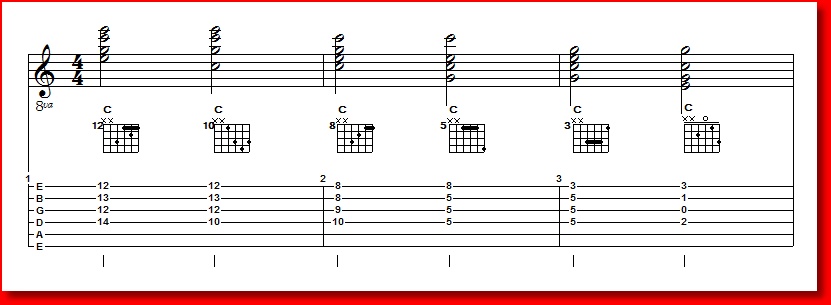
Appendix 3 - Lesson 1
Major Chord Forms
Notes
Major Triad Forms: Since the Major Triad is the root of all major chords' forms, including Dominant, let's look at these forms:

Major Triad Chord Forms
I've used our old if not our oldest friend, the C Major triad in our example. For the rest of this lesson, we'll remain in the Key of C. Note that we have six forms with two each of each chord note on the 1st string. Measure 1 features the E or 3rd of the C chord, Measure 2 features the root or C note, and Measure 3 features the G or the 5th of the C chord. Let's think of the note on the 1st string as a pivot note. That is to say, in each pair, one chord form has our hand closer to the bridge, and the other closer to the nut. We can use this feature to facilitate the chord change to the next form. Using open strings or long stretches, we can construct more C triads, but these are all the forms we need to get started.
Major 7 Forms: Adding the 7th or a B note to a C triad gives us a C Maj7 form. We just find one of the roots in whatever triad and move it one fret lower. Keep in mind our rule that we must use at least the 3rd and the color notes. That makes constructing our chords from triads simpler. The 3rd, 5th, and 7th of any Maj7 chord makes a minor triad. An E minor can always substitute for a C Maj7. Therefore, we can make a rule:
The iii chord will always substitute for a I Maj7 chord.
Here are the Maj7 forms:
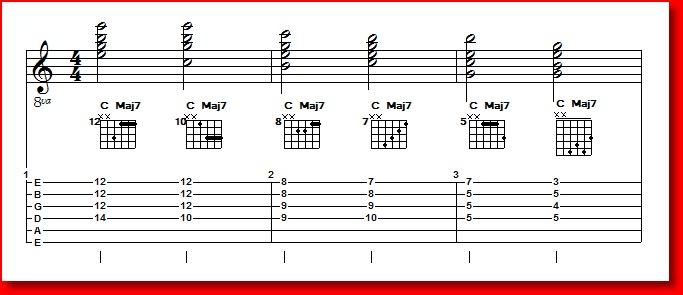
Major 7 Forms
Note that the first and sixth chords are actually E min triads. There are more minor triads that we'll study later. Also note that we still can apply the pivot note principle as mentioned in Major Triads. Using extra long stretches and open strings, we can construct other forms. But these are movable and can be used in any key.
Major 6 Forms: Adding the 6th or an A note to a C triad gives us a C Maj6 form. From our study with Mickey Baker, we learned that a C Maj6 is also an A min7. Or we can make a chord rule: I6 is also a vi7 chord. Here are the Major 6 forms:
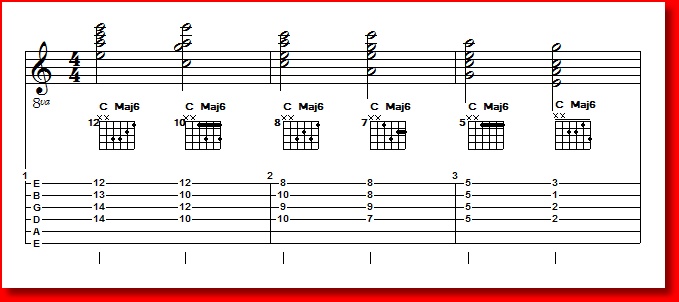
Major 6 Chord Forms
Note that the first and third forms are actually an A min triad. That fits our rule of at least the 3rd (E) and 6th (A) must be in the chord, All of these are old friends from our study with Mickey. Did a little light come on when you realized that E min to A min (in C, iii to vi) will always substitute for I Maj7 to I Maj6?
Major 9 and 6/9 Forms: In Mickey's course, we just scratched the surface of Major 9 and 6/9 chords. In the additional material I gave some of these forms and progressions. Let's say we have two measures of C harmony. Typically, Mickey would play a I Maj7 to I Maj6 to I Maj7 to I Maj6. That still stands. A variation is to start with a I Maj9 to I6/9 to I Maj7 to a I Maj6. Our next example gives some melody Maj9 to 6/9 progressions:
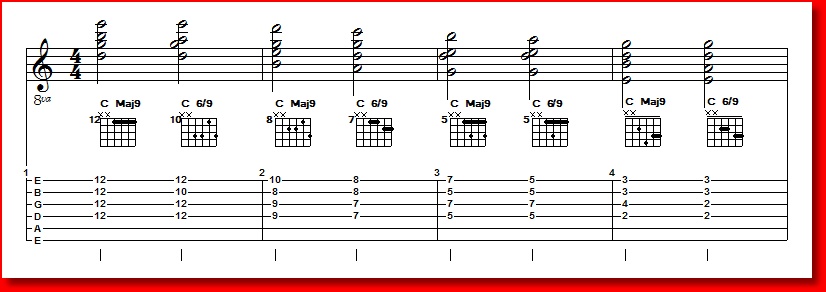
Major 9 to 6/9 Progressions
I combined the Major 9 and 6/9 chords because the Maj9 forms are identical to the Major 6 forms, only on different frets. One of the 6/9 chords is from Mickey's course and the other two are discussed in his Volume 2. Listen to either the MIDI playback, or play these forms on the guitar.
Review of Major Chord Forms: Here's a 4-measure example of the chord progression we discussed in the Major 9 to 6/9 paragraph:
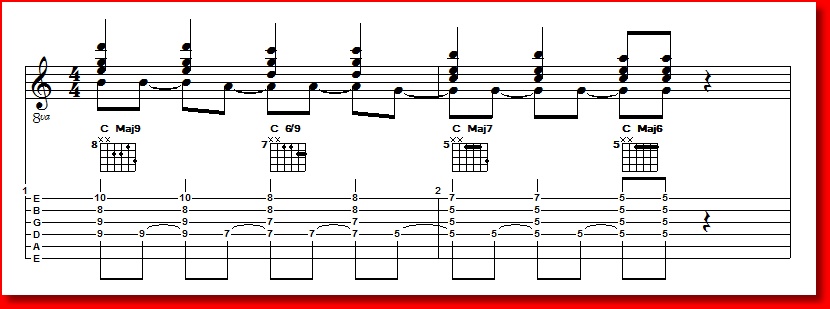
An Example of a Major Chord Progression
This progression substitutes for two measures of C, but really seems active. Using Mickey's rules for chord substitution, make up your own progressions with the chords from above. Play any of tunes you have in your "Standards Portfolio" and substitute these progressions in them and watch your arrangements take on a new life.
Just keep it fun!